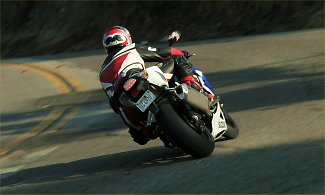
After its last-place finish in MD’s 2004 Open-Class Sportbike comparison, as expected, Suzuki introduced an entirely new GSX-R1000 for the 2005 model year. We have already discussed in detail the technical specifications of this motorcycle, including its engine, chassis and suspension changes for 2005. We won’t repeat that discussion, but will get right to our riding experience.

We have said it before, but 1000cc sportbikes are now so powerful that the way in which the engine delivers that power has taken on extreme importance. All of these bikes produce in excess of 150 rear-wheel horsepower in a package weighing less than 400lbs dry. All the manufacturers are smart enough to know that this kind of horsepower must be meted out progressively so that the “Average Joe” can enjoy the bike without getting hurt.
To no one’s surprise, Suzuki worked hard at smoothing out the somewhat abrupt low-end power found in the 2004 model. Getting right to our bottom line, the 2005 GSX-R1000 offers more low-end and midrange power than any 1000cc sportbike we have ever tested and, more importantly, offers that power in a smooth, linear fashion that keeps the rear wheel hooked up (when you want it to be) and the bike driving forward out of corners in a controlled show of force. If you think Troy Corser and Mat Mladin have an advantage over their racetrack competitors when it comes to corner exit acceleration, wait until you show your buddies just how quickly the stock GSX-R1000 exits corners on the street in virtually any gear (taching as low as 4000rpm).

Suffice it to say that at streetable RPM levels on these 1000cc beasts, the Suzuki is now king.
Did Suzuki sacrifice peak horsepower to gain all of this low-rpm thrust? No way. This bike has consistently dyno’d with higher peak horsepower than any other bike in the class, and the rider has no reason to doubt the dyno figures once he finds the nerve to hold the throttle wide open as the tach approaches redline on the GSX-R1000. By the way, unless you want to wheelie this machine, be judicious when you roll on the throttle in the lower gears (particularly, first and second).
Although the engine offers plenty of controllable thrust (class-leading, in fact), it is not the smoothest engine available in the category. A bit buzzy at times, particularly, compared to Kawasaki’s ZX-10R, the GSX-R1000 is not objectionably so. You could argue that the minimal vibration lends some character to this bike, but the real character comes from the intake and exhaust noises that are so typical of Suzuki’s GSX-Rs. This engine not only delivers the goods, it sounds bad-ass while doing so.
You would hope that Suzuki would put this monster of an engine in a worthy chassis. They have.
Beginning with the brakes, Suzuki has rectified one of the glaring weaknesses of its 2004 model. Two, radial-mount four-piston front brake calipers squeeze larger 310mm rotors with the power of a new radial master cylinder. The result on the road is outstanding power and control. Although lacking the initial bite of Honda’s CBR1000RR, the front brake lever is reasonably progressive, allowing you to take the front tire right to the edge of traction and hold it there if need be.

The relatively tiny chassis (this bike feels smaller than some 600s) features reasonably comfortable ergonomics for the class, although the footpegs are still a bit high and forward feeling. You definitely notice the narrower fuel tank and frame rails, which contributes to a lightweight feel.
The fully adjustable 43mm fork still has a low friction coating on the lower tubes, while the fully adjustable rear shock features a more linear linkage rate compared to 2004.

The fork is difficult to criticize on the street. It offers good compliance, yet is stiff enough to be pushed hard. The shock features good, progressive damping, but is really too soft when the bike is ridden aggressively by larger riders. A stiffer spring in the back would go a long way toward resolving this, and it really is a non-issue for 90% of street riding.
No complaints about the big Suzuki’s transmission. A tall first gear is not a problem for this bike given its massive low-end power (unlike Yamaha’s R1, which feels like it is geared much too tall at street RPM levels). A close-ratio six-speed transmission isn’t really necessary under most circumstances when you have this much power spread over 7000rpm, or so. Let us put it this way – you will never have a problem finding the right gear for any situation (in fact, maybe 2 or 3 “right gears”).

This bike also handles extremely well. With a stock steering damper, the GSX-R1000 exhibits rock-solid stability while still changing directions easier than most bikes in the class (with the exception of Kawasaki’s ZX-10R). It is easy to understand why racers had no trouble setting up their GSX-R1000 race bikes to go fast with very little testing. Somehow, Suzuki found the right combination of “tuned flex” and geometry.
In the final analysis, Suzuki has taken engine performance to a new level in this category, and combined it with a very capable chassis. How does it compare with the winner of MD’s 2004 Open Class comparison, the Kawasaki ZX-10R? Stay tuned for another article answering that question. In the meantime, check out Suzuki’s web site for additional details and specifications for the 2005 GSX-R1000, which retails at a suggested MSRP of $10,849 in the United States.






